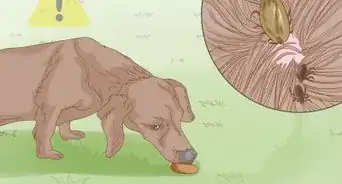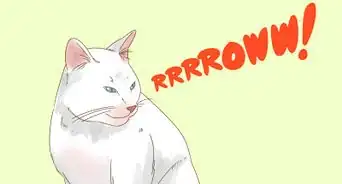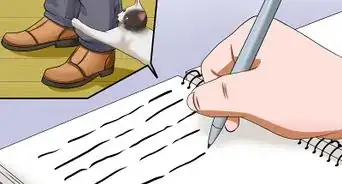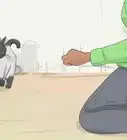This article was co-authored by wikiHow Staff. Our trained team of editors and researchers validate articles for accuracy and comprehensiveness. wikiHow's Content Management Team carefully monitors the work from our editorial staff to ensure that each article is backed by trusted research and meets our high quality standards.
This article has been viewed 11,698 times.
A deer grunt can be a highly helpful tool. It is a small tube you blow into to produce grunting sounds similar to the noises deer make in the wild. To use a grunt call effectively, you'll need to master different sounds for different situations. Make sure you target deer that are active and energetic. Every deer is different and some will not readily respond to a call. Do not get discouraged, however. Using the call persistently should eventually attract deer.
Steps
Using Different Grunts
-
1Blow into the grunt to make a noise. You use a grunt call by pressing your mouth against the mouthpiece. Then, blow into the grunt the same way you would blow into something like a whistle or musical instrument. It should produce a noise similar to a deer call.
-
2Do two or three short grunts for out of sight deer. Grunt calls can be used periodically when there are no deer in range to entice deer to enter your area. Out of range deer are best attracted by two or three medium grunts. These grunts should be only a couple of seconds long each and let out in quick succession.[1]
-
3Do longer grunts for deer you can see. If you see a deer in the distance that's not facing your direction, it can be encouraged to enter the shooting range with a grunt call. Do one or two longer grunts, a few seconds longer than the shorter grunts used for out of sight deer. This can get a deer to turn around and enter your area.[2]
-
4Make soft, fast grunts for deer coming into range. If a buck starts coming in from out of range, you can further encourage it with brief, short grunts. Cup your hand around the end of your grunt call. Wrap and unwrap your hand around the call while blowing into the mouthpiece to create very short grunts in quick succession. These should be less than a second long.[3]
Using the Call Effectively
-
1Set up in a good spot for grunting. You shouldn't use a grunt call just anywhere. You need to pick an area in which deer gather. Deer may be suspicious of calls coming from strange areas. When using a grunt call, it's best to hunt near a thicket or a water source, such as a creek or stream.[4]
-
2Blind call every 30 minutes. When you first set up camp, you're unlikely to see deer for awhile. "Blind calling" means blowing your call without deer present in hopes of attracting deer to your area. Blind calling continuously may make deer suspicious, so limit blind calling to every 30 minutes until you see a deer.[5]
- Remember, two or three short grunts is best when blind calling.[6]
-
3Target more active deer. Deer that are eating or drinking are unlikely to be seeking out other bucks or does. Active deer that are running, charging, or chasing other deer are the most likely to respond to a grunt call. It's a waste of time to target deer that are focused on food and water, as they're unlikely to respond.
-
4Keep grunting once a deer notices the sound. Be a little aggressive when using the call, as this can effectively lure deer. If a deer stops to listen to your call, keep grunting. This may entice the deer to eventually step into shooting range.[7]
- Remember to use longer grunts to attract a deer you can see. Make one or two long grunts and then pause before grunting again.[8]
-
5Try incorporating a doe bleat. Some grunt calls have a special setting called a "doe bleat." You can also bring a second call with you specifically designed to imitate doe bleats. This can attract bucks looking to mate. Doe bleats work best if you occasionally add a doe bleat into your blind calling routine.[9]
Avoiding Common Mistakes
-
1Practice at home first. Never go out into hunting grounds if haven't practiced using your deer grunt call. At home, take out your deer grunt call and practice using it to make sure you know how to make the basic sounds. If you need to use your grunt call to attract a deer, you'll need to act fast.
- Make sure you practice in sound proof area, like your basement, to avoid bothering your neighbors.
-
2Do not use a call when a deer can see you. If a deer is staring at you, put your call away. A deer is likely to run from a grunt call if it can clearly see it's coming from a human source.[10]
-
3Avoid grunting if a buck's within 75 yards (68 meters). Once your deer is in range, there's no need to use a grunt call. First off, the deer is close enough to shoot already. Second, using a grunt call when a deer is close by may cause it to see you. The deer may flee, ruining your chances of shooting it.[11]
-
4Do not grunt at a buck following a doe. If a doe is already leading your buck in range, there is no need to grunt. However, does may also lead a buck out of range. If a buck is trying to mate with a doe, it's unlikely to be deterred, even with aggressive grunting. In this case, unfortunately, you'll have to let the deer go.
-
5Be persistent when using your call. Every deer is different. Some deer readily respond to grunt calls while others ignore them. Keep using your grunt call, even if it does not seem to be attracting deer. Usually, a deer will bite eventually if you're persistent with your calling.[12]
References
- ↑ https://www.youtube.com/watch?v=JcxAklUHW8I
- ↑ https://www.youtube.com/watch?v=JcxAklUHW8I
- ↑ https://www.youtube.com/watch?v=JcxAklUHW8I
- ↑ http://www.northamericanwhitetail.com/tactics/deer-grunting-tips-from-3-whitetail-experts/
- ↑ http://www.outdoorlife.com/blogs/master-class/2013/11/deer-hunting-tips-how-really-use-grunt-call
- ↑ https://www.youtube.com/watch?v=JcxAklUHW8I
- ↑ http://www.outdoorlife.com/blogs/master-class/2013/11/deer-hunting-tips-how-really-use-grunt-call
- ↑ https://www.youtube.com/watch?v=JcxAklUHW8I
- ↑ http://www.northamericanwhitetail.com/tactics/deer-grunting-tips-from-3-whitetail-experts/
About this article
To deer grunt, start by setting up in a good spot where deer tend to gather. Next, press your mouth against the mouthpiece and blow into the grunt the same way you would blow into a whistle. For out of range deer, do 2-3 short grunts every 30 minutes or so. If a deer is visible to you, do 1-2 long grunts, then pause and repeat the long grunts again. Once your deer is within 75 yards and clearly visible, stop grunting and prepare to take your shot! For tips on targeting active, energetic deer with grunting, read on!
































